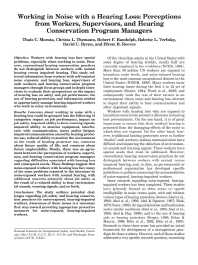Mining Publication: Working in Noise with a Hearing Loss: Perceptions from Workers, Supervisors, and Hearing Conservation Program Managers
Original creation date: December 2005
Workers with hearing loss face special problems, especially when working in noise. However, conventional hearing conservation practices do not distinguish between workers with normal hearing versus impaired hearing. This study collected information from workers with self-reported noise exposure and hearing loss, supervisors of such workers, and hearing conservation program managers through focus groups and in-depth interviews to evaluate their perspectives on the impact of hearing loss on safety and job performance, the use of hearing protection, and information needed to appropriately manage hearing-impaired workers who work in noisy environments. Concerns about working in noise with a hearing loss could be grouped into the following 10 categories: impact on job performance, impact on job safety, impaired ability to hear warning signals, impaired ability to monitor equipment, interference with communication, stress and/or fatigue, impaired communication caused by hearing protector use, reduced ability to monitor the environment as the result of hearing protector use, concerns about future quality of life, and concerns about future employability. Mostly, there was an agreement between the perceptions of workers, supervisors, and hearing conservation program managers regarding difficulties associated with hearing loss and consequent needs. These findings suggest that noise-exposed workers with hearing loss face many of the same problems reported in the literature by noise-exposed workers with normal hearing, with additional concerns primarily about job safety as the result of a reduced ability to hear environmental sounds, warning signals, and so forth. The study outlines potential challenges regarding job safety and hearing conservation practices for noise-exposed, hearing-impaired workers. Awareness of these issues is a necessary first step toward providing appropriate protective measures for noise-exposed, hearing-impaired workers.
Authors: TC Morata, CL Themann, RF Randolph, BL Verbsky, DC Byrne, ER Reeves
Peer Reviewed Journal Article - December 2005
NIOSHTIC2 Number: 20029296
Ear Hearing 2005 Dec 26(6):529-545
See Also
- Development and Evaluation of a Urethane Jacketed Tail Roller for Continuous Mining Machines
- Evaluation and Development of Hearing Loss Interventions
- Hearing Loss Prevention in Mining - 2005
- NIOSH Hearing Loss Simulator Instruction and Training Guide
- Noise and Hearing Protection: Development of Two Training Exercises for Drillers
- Noise Source Identification on a Continuous Mining Machine
- Noise Source Identification on a Horizontal Vibrating Screen
- Snapshot of Noise and Worker Exposures in Sand and Gravel Operations
- Water Well Safety Bits: Health And Safety Information For The Water Well Industry
- What Does a Hearing Loss Sound Like?
- Content source: National Institute for Occupational Safety and Health, Mining Program


 ShareCompartir
ShareCompartir
